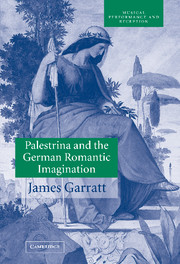Book contents
- Frontmatter
- Contents
- Acknowledgements
- List of abbreviations
- Introduction
- 1 Historicism in nineteenth-century art, aesthetics and culture
- 2 Romanticism and the problem of church music
- 3 The Protestant Palestrina revival
- 4 The Catholic Palestrina revival
- 5 Palestrina in the concert hall
- 6 Interpreting the secondary discourse of nineteenth-century music
- Notes
- Bibliography
- Index
4 - The Catholic Palestrina revival
Published online by Cambridge University Press: 12 October 2009
- Frontmatter
- Contents
- Acknowledgements
- List of abbreviations
- Introduction
- 1 Historicism in nineteenth-century art, aesthetics and culture
- 2 Romanticism and the problem of church music
- 3 The Protestant Palestrina revival
- 4 The Catholic Palestrina revival
- 5 Palestrina in the concert hall
- 6 Interpreting the secondary discourse of nineteenth-century music
- Notes
- Bibliography
- Index
Summary
TRADITION AND REFORM
In discussing the relation between the Palestrina revival and the composition of church music in Catholic south Germany and Austria, several distinctions must be borne in mind. Although the work of south German reformers was naturally stimulated by the ideas and activities of their north German counterparts, the Catholic Palestrina revival was sustained by significantly different historical, intellectual and ideological foundations. While the idealization and emulation of Palestrina by Protestant composers was a product of historicism, Catholic church music evinces a bifurcated orientation: in addition to the historicist revival of Palestrina's music and language, Catholic music reflects Palestrina indirectly through the perpetuation of the Fuxian stylus a capella. As well as exploring the tension between historicism and tradition, it is necessary to confront the distinct ideological factors that shaped the Catholic Palestrina revival. While, as has been seen, the strengthening Catholic particularism in the early years of the Second Reich contributed to Palestrina being displaced as the paradigm for Protestant church music, this factor had the opposite effect in Catholic south Germany. Indeed, it is activities in this period, especially the reforms and music of the Allgemeine Deutsche Cäcilien-Verein (ACV), that must form the focal point of an examination of the Catholic Palestrina revival.
Even though the ACV was the most influential contemporary movement for church music reform, it would be mistaken to view the Catholic Palestrina revival as synonymous with its activities.
- Type
- Chapter
- Information
- Palestrina and the German Romantic ImaginationInterpreting Historicism in Nineteenth-Century Music, pp. 133 - 213Publisher: Cambridge University PressPrint publication year: 2002

